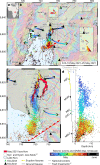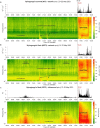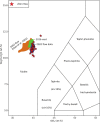Precursor-free eruption triggered by edifice rupture at Nyiragongo volcano
- PMID: 36045241
- PMCID: PMC9433316
- DOI: 10.1038/s41586-022-05047-8
Precursor-free eruption triggered by edifice rupture at Nyiragongo volcano
Abstract
Classical mechanisms of volcanic eruptions mostly involve pressure buildup and magma ascent towards the surface1. Such processes produce geophysical and geochemical signals that may be detected and interpreted as eruption precursors1-3. On 22 May 2021, Mount Nyiragongo (Democratic Republic of the Congo), an open-vent volcano with a persistent lava lake perched within its summit crater, shook up this interpretation by producing an approximately six-hour-long flank eruption without apparent precursors, followed-rather than preceded-by lateral magma motion into the crust. Here we show that this reversed sequence was most likely initiated by a rupture of the edifice, producing deadly lava flows and triggering a voluminous 25-km-long dyke intrusion. The dyke propagated southwards at very shallow depth (less than 500 m) underneath the cities of Goma (Democratic Republic of the Congo) and Gisenyi (Rwanda), as well as Lake Kivu. This volcanic crisis raises new questions about the mechanisms controlling such eruptions and the possibility of facing substantially more hazardous events, such as effusions within densely urbanized areas, phreato-magmatism or a limnic eruption from the gas-rich Lake Kivu. It also more generally highlights the challenges faced with open-vent volcanoes for monitoring, early detection and risk management when a significant volume of magma is stored close to the surface.
© 2022. The Author(s).
Conflict of interest statement
The authors declare no competing interests.
Figures











Comment in
-
The search for eruption signals in volcanic noise.Nature. 2022 Sep;609(7925):36-38. doi: 10.1038/d41586-022-02347-x. Nature. 2022. PMID: 36045232 No abstract available.
References
-
- Caricchi L, Townsend M, Rivalta E, Namiki A. The build-up and triggers of volcanic eruptions. Nat. Rev. Earth Environ. 2021;2:458–476.
-
- Scarpa R. Predicting volcanic eruptions. Science. 2001;293:615–616. - PubMed
-
- Sparks RSJ. Forecasting volcanic eruptions. Earth Planet. Sci. Lett. 2003;210:1–15.
-
- Chaussard E, Amelung F, Aoki Y. Characterization of open and closed volcanic systems in Indonesia and Mexico using InSAR time series. J. Geophys. Res. Solid Earth. 2013;118:3957–3969.
-
- Reath K, et al. Using conceptual models to relate multiparameter satellite data to subsurface volcanic processes in Latin America. Geochem. Geophys. Geosyst. 2020;21:e2019GC008494.
Publication types
LinkOut - more resources
Full Text Sources

